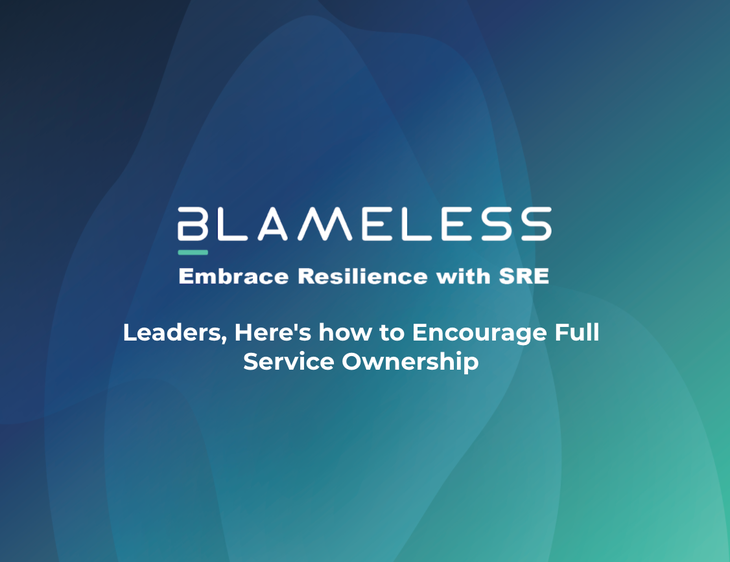Leaders, Here's how to Encourage Full Service Ownership

Originally published on Failure is Inevitable.
Service ownership is becoming common practice and its benefits are well-known. These perks include happier customers, aligned teams, and fewer incidents.
While this sounds great, it’s often easier said than done, requiring a culture and mindset shift. Leadership will need to encourage and empower teams to adopt the “you build it, you run it” mentality.
Here are some ways leaders can help get teams on board.
Start at the team level
If teams work against each other, service ownership will not succeed. Uniting these teams requires non-local optimization. This means making sure that all teams align on the most important, shared goal and do their part to drive towards it.
As Instacart’s VP of Infrastructure Dustin Pearce said in a recent AMA, “If I'm saying that I care about product innovation because that's what's good for the company, I'm already demonstrating non-local optimization for the greater good. That helps build the bridges required to get aligned.”
Leadership will need to perform a balancing act. Teams that usually have competing incentives (say security and feature development) should instead be united on doing what’s best for customers, as that’s what’s best for the business. And, if a team’s goals don’t contribute to the company goal, the team should reframe its goals.
“You need systems thinking and teamwork, not local optimization for your metric. If I get paid a bonus if everyone finishes their security tickets on time, I'm going to locally optimize for that. As a CTO, how are you incentivizing your senior leadership to operate as a team? That's key to this concept as well,” Dustin noted.
When a team owns a service, that team handles both new features and reliability. As the Spotify tribe model has become popularized, we see that autonomous, cross-functional (dev, ops, product) teams organized around feature areas are better positioned to scale while focusing on customer outcomes.
Get the engineering managers involved
Once team incentives become aligned, it’s time to make sure managers are on board. One of the best ways to do this is by recognizing the importance of managers.
Dustin noted, “In models that embrace service ownership, a lot collides with the engineering manager. Engineering manager is becoming a difficult role in this world. It is no longer just supporting engineers and managing your Agile backlog. You have many stakeholders.”
Engineering managers are often responsible for much more than making sure teams complete sprints on time. They also are the contact points for:
- Reporting on service health at the executive level
- Communicating team needs and acting as an advocate for team members
- Capacity planning and tracking business needs
Describing the benefits of service ownership may help. According to PagerDuty’s Julie Gunderson, full service ownership fosters the following benefits:
- Accountability around delivering high-quality work
- A shared mindset of systems thinking, reducing single points of failure
- Continuous improvement and refinement of alerting, monitoring, and other processes
- Improved psychological safety
Thus, service ownership helps engineering managers instill a culture of shipping higher-quality, more performant code. Furthermore, when things do break, service interruptions can be mitigated more effectively. After all, if there’s an issue with a deploy or change, the engineer who made it will be the one responsible for answering that call.
“The leaders are very much instrumental in shaping this culture. There are all kinds of great phrases I've heard over the years. One is that your culture is defined by the worst behavior you'll tolerate. That's the advice they give leaders to give them the courage to take a stand for the things they believe in,” said Dustin.
If service ownership is an important initiative, make sure that the whole team knows this. Bake it into the day-to-day operations of your teams. Culture is key to success.
Building a culture of service ownership
If service ownership boils down to a list of to-dos and more time on call, it’s not likely to succeed. It needs to be an integral part of the culture. There are two ways to encourage this.
- Customer-first mentality: Dustin noted, “At Slack, I used to walk around with my own pithy phrase: ‘We don't ship software, we craft and care for customer experiences.’ We are not shipping boxes here. We create the software and we own it for you.” Customers are at the heart of everything successful software companies do. Afterall, if a product has no users, is it worth keeping the lights on? Use SLOs to help enable service ownership by aligning on metrics and incentives. Bad experiences lead customers to churn, and churn effects more than the bottom line. Bad service also hurts the brand, limiting possible future opportunities. “P90 is not a thing anymore. I can't just write off 10% of my users' experience and say P90 is good. I need almost individual—even across tens of millions of users—visibility into those experiences. That's the direction service ownership is taking now,” Dustin said.
- Celebrate failure and courage: It’s frightening to try something new. It’s frightening to make mistakes. It’s frightening to be paged late on Friday night for a product you own. This transition to service ownership will likely incite fear in many team members. To overcome this, you need to create a psychologically safe environment. People need to know that their mistakes won’t cost them their jobs. Instead, it’s a learning opportunity that makes everyone better. By feeding these learnings back into your development lifecycle, your team will grow. It’ll get better and won’t make the same mistakes repeatedly. You’ll see fewer incidents, faster time to resolution, and a boost in morale.
Without the culture in place, service ownership cannot succeed. Culture comes first, and service ownership comes second.
We’ll leave you with one last quote from Dustin on the importance of culture:
“If I said the perfect culture is some place that celebrates courageous decision-making on the front lines by engineering managers, then you have to invest your time as a founder, as the CEO, as a VP, to celebrate the fact that the manager—hopefully with the support and alignment of their team and not autocratically—is making courageous decisions. Even when they're wrong, you're celebrating the fact that they're doing it right. There's no shortcuts there, and you have to be consistent.”
If you liked this article, check these out:
Get similar stories in your inbox weekly, for free
Share this story:

Blameless
Blameless is the industry's first end-to-end SRE platform, empowering teams to optimize the reliability of their systems without sacrificing innovation velocity.
Latest stories
How ManageEngine Applications Manager Can Help Overcome Challenges In Kubernetes Monitoring
We tested ManageEngine Applications Manager to monitor different Kubernetes clusters. This post shares our review …
AIOps with Site24x7: Maximizing Efficiency at an Affordable Cost
In this post we'll dive deep into integrating AIOps in your business suing Site24x7 to …
A Review of Zoho ManageEngine
Zoho Corp., formerly known as AdventNet Inc., has established itself as a major player in …
Should I learn Java in 2023? A Practical Guide
Java is one of the most widely used programming languages in the world. It has …
The fastest way to ramp up on DevOps
You probably have been thinking of moving to DevOps or learning DevOps as a beginner. …
Why You Need a Blockchain Node Provider
In this article, we briefly cover the concept of blockchain nodes provider and explain why …
Top 5 Virtual desktop Provides in 2022
Here are the top 5 virtual desktop providers who offer a range of benefits such …
Why Your Business Should Connect Directly To Your Cloud
Today, companies make the most use of cloud technology regardless of their size and sector. …
7 Must-Watch DevSecOps Videos
Security is a crucial part of application development and DevSecOps makes it easy and continuous.The …








